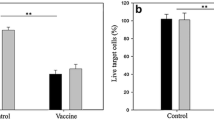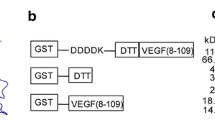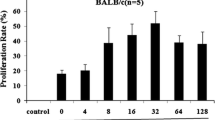Abstract
Passive immunotherapy against soluble pro-angiogenic factors and/or their receptors in endothelial cells has become a promising approach in cancer therapeutics. There is also experimental evidence indicating that an active immunotherapy strategy directed towards these target molecules could also be effective. In this paper we show that it is possible to reduce tumor growth or increase the survival of tumor-bearing C57Bl/6 mice when animals are vaccinated with the human vascular endothelial growth factor (VEGF) isoform 121 gene (hVEGF121), and later challenged with melanoma or lung carcinoma tumor cells. Immunization was done with 10 μg DNA doses of the hVEGF121 gene, which is highly homologous to its mouse counterpart, administered on a weekly basis using a plasmid bearing 5 CpG bacterial motifs. Histopathology analyses of tumors of hVEGF121 immunized animals showed a decrease in tumor cell density around vessels and in mitotic figures, as well as an increase in apoptotic tumor cells. A statistically significant cell cytotoxic response was found when spleen cells of immunized mice were co-cultured in vitro with mouse tumor VEGF-producing cells. Vaccination with an hVEGF121 gene mutated to make it deficient for VEGF receptor binding, produced similar in vitro and in vivo results, and significantly reduced the number of spontaneous metastases produced by the mouse Lewis lung carcinoma. Our results indicate that human VEGF DNA can be employed for anti-angiogenic active immunotherapy in mice, and that direct cell cytotoxicity is a contributor mechanism to the overall anti-tumor effects seen in immunized animals.









Similar content being viewed by others
References
Folkman J (2002) Role of angiogenesis in tumor growth and metastasis. Semin Oncol 29:15–18
Folkman J (2003) Angiogenesis and apoptosis. Semin Cancer Biol 13:159–167
Ohm JE, Carbone DP (2001) VEGF as a mediator of tumor-associated immunodeficiency. Immunol Res 23:263–272
Ferrara N, Gerber HP, Lecouter J (2003) The biology of VEGF and its receptors. Nat Med 9:669–676
Ferrara N, Hillan KJ, Novotny W (2005) Bevacizumab (Avastin), a humanized anti-VEGF monoclonal antibody for cancer therapy. Biochem Biophys Res Commun 333:328–335
Ferrara N, Hillan KJ, Gerber HP, Novotny W (2004) Discovery and development of bevacizumab, an anti-VEGF antibody for treating cancer. Nat Rev Drug Discov 3:391–400
Midgley R, Kerr D (2005) Bevacizumab – current status and future directions. Ann Oncol 16:999–1004
Jayson GC, Zweit J, Jackson A et al (2002) Molecular imaging and biological evaluation of HuMV833 anti-VEGF antibody: implications for trial design of antiangiogenic antibodies. J Natl Cancer Inst 94:1484–1493
Zhang W, Ran S, Sambade M, Huang X, Thorpe PE (2002) A monoclonal antibody that blocks VEGF binding to VEGFR2 (KDR/Flk-1) inhibits vascular expression of Flk-1 and tumor growth in an orthotopic human breast cancer model. Angiogenesis 5:35–44
Zhu Z, Hattori K, Zhang H et al (2003) Inhibition of human leukemia in an animal model with human antibodies directed against vascular endothelial growth factor receptor 2. Correlation between antibody affinity and biological activity. Leukemia 17:604–611
Tartour E, Fridman WH (2000) Cancer vaccine 2000. Immunol Lett 74:1–3
Wei YQ, Huang MJ, Yang L et al (2001) Immunogene therapy of tumors with vaccine based on Xenopus homologous vascular endothelial growth factor as a model antigen. Proc Natl Acad Sci USA 98:11545–11550
Zagury D, Gallo RC (2004) Anti-cytokine Ab immune therapy: present status and perspectives. Drug Discov Today 9:72–81
Liu JY, Wei YQ, Yang L et al (2003) Immunotherapy of tumors with vaccine based on quail homologous vascular endothelial growth factor receptor-2. Blood 102:1815–1823
Lu F, Qin ZY, Yang WB, Qi YX, Li YM (2004) A DNA vaccine against extracellular domains 1–3 of flk-1 and its immune preventive and therapeutic effects against H22 tumor cell in vivo. World J Gastroenterol 10:2039–2044
Niederman TM, Ghogawala Z, Carter BS, Tompkins HS, Russell MM, Mulligan RC (2002) Antitumor activity of cytotoxic T lymphocytes engineered to target vascular endothelial growth factor receptors. Proc Natl Acad Sci USA 99:7009–7014
Reisfeld RA, Niethammer AG, Luo Y, Xiang R (2004) DNA vaccines designed to inhibit tumor growth by suppression of angiogenesis. Int Arch Allergy Immunol 133:295–304
Herrera AM, Rodriguez EG, Hernandez T, Sandez B, Duarte CA (2000) A family of compact plasmid vectors for DNA immunization in humans. Biochem Biophys Res Commun 279:548–551
Lin KY, Guarnieri FG, Staveley-O’Carroll KF et al (1996) Treatment of established tumors with a novel vaccine that enhances major histocompatibility class II presentation of tumor antigen. Cancer Res 56:21–26
Eisenbach L, Hollander N, Greenfeld L, Yakor H, Segal S, Feldman M (1984) The differential expression of H-2K versus H-2D antigens, distinguishing high-metastatic from low-metastatic clones, is correlated with the immunogenic properties of the tumor cells. Int J Cancer 34:567–573
Rodriguez EG, Vazquez DM, Herrera AM, Duarte CA (2003) Enhanced cell-mediated INF-gamma secreting activity against the HIV IIIB V3 peptide of the TAB9 multiepitope after DNA vaccine backbone engineering. Biochem Biophys Res Commun 308:713–718
Shen BQ, Lee DY, Gerber HP, Keyt BA, Ferrara N, Zioncheck TF (1998) Homologous up-regulation of KDR/Flk-1 receptor expression by vascular endothelial growth factor in vitro. J Biol Chem 273:29979–29985
Ojalvo AG, Seralena A, Vázquez R et al (2003) Therapeutic angiogenesis following intramuscular gene transfer of vascular endothelial growth factor 121 in a dog model of hindlimb ischemia. Electronic J Biotechnol 6:208–222
Li Y, Wang MN, Li H et al (2002) Active immunization against the vascular endothelial growth factor receptor flk1 inhibits tumor angiogenesis and metastasis. J Exp Med 195:1575–1584
Wyllie AH (1980) Glucocorticoid-induced thymocyte apoptosis is associated with endogenous endonuclease activation. Nature 284:555–556
Morera Y, Lamdan H, Bequet M et al (2006) Biologically active vascular endothelial growth factor as a bacterial recombinant glutathione S-transferase fusion protein. Biotechnol Appl Biochem 44:45–53
Li Z, Zhang H, Fan X et al (2006) DNA electroporation prime and protein boost strategy enhances humoral immunity of tuberculosis DNA vaccines in mice and non-human primates. Vaccine 24:4565–4568
Jakob T, Walker PS, Krieg AM, Udey MC, Vogel JC (1998) Activation of cutaneous dendritic cells by CpG-containing oligodeoxynucleotides: a role for dendritic cells in the augmentation of Th1 responses by immunostimulatory DNA. J Immunol 161:3042–3049
Davis HL, Weeratna R, Waldschmidt TJ, Tygrett L, Schorr J, Krieg AM (1998) CpG DNA is a potent enhancer of specific immunity in mice immunized with recombinant hepatitis B surface antigen. J Immunol 160:870–876
Sun S, Kishimoto H, Sprent J (1998) DNA as an adjuvant: capacity of insect DNA and synthetic oligodeoxynucleotides to augment T cell responses to specific antigen. J Exp Med 187:1145–1150
Plum SM, Fogler WE (2004) Anti-angiogenic vaccines as a treatment modality for cancer. Curr Opin Investig Drugs 5:1243–1246
Brand A (2002) Immunological aspects of blood transfusions. Transpl Immunol 10:183–190
Niethammer AG, Xiang R, Becker JC et al (2002) A DNA vaccine against VEGF receptor 2 prevents effective angiogenesis and inhibits tumor growth. Nat Med 8:1369–1375
Ferrara N, Winer J, Burton T et al (1993) Expression of vascular endothelial growth factor does not promote transformation but confers a growth advantage in vivo to Chinese hamster ovary cells. J Clin Invest 91:160–170
Agnantis NJ, Goussia AC, Batistatou A, Stefanou D (2004) Tumor markers in cancer patients. an update of their prognostic significance. Part II. In Vivo 18:481–488
Shinkaruk S, Bayle M, Lain G, Deleris G (2003) Vascular endothelial cell growth factor (VEGF), an emerging target for cancer chemotherapy. Curr Med Chem Anti -Canc Agents 3:95–117
Keyt BA, Nguyen HV, Berleau LT et al (1996) Identification of vascular endothelial growth factor determinants for binding KDR and FLT-1 receptors. Generation of receptor-selective VEGF variants by site-directed mutagenesis. J Biol Chem 271:5638–5646
Kim KJ, Li B, Houck K, Winer J, Ferrara N (1992) The vascular endothelial growth factor proteins: identification of biologically relevant regions by neutralizing monoclonal antibodies. Growth Factors 7:53–64
Kitamoto Y, Tokunaga H, Miyamoto K, Tomita K (2002) VEGF is an essential molecule for glomerular structuring. Nephrol Dial Transplant 17(Suppl 9):25–27
Herbst RS, Sandler AB (2004) Non-small cell lung cancer and antiangiogenic therapy: what can be expected of bevacizumab? Oncologist 9 Suppl 9(Suppl 1):19–26
Sandler AB, Johnson DH, Herbst RS (2004) Anti-vascular endothelial growth factor monoclonals in non-small cell lung cancer. Clin Cancer Res 10:4258s–4262s
Acknowledgements
We thank Y. Soria for excellent technical assistance in animal handling and A. Vásquez for the histopathology analyses. We are also grateful to Dr. T. C. Wu for providing the TC-1 carcinoma model.
Author information
Authors and Affiliations
Corresponding author
Rights and permissions
About this article
Cite this article
Bequet-Romero, M., Ayala, M., Acevedo, B.E. et al. Prophylactic naked DNA vaccination with the human vascular endothelial growth factor induces an anti-tumor response in C57Bl/6 mice. Angiogenesis 10, 23–34 (2007). https://doi.org/10.1007/s10456-006-9062-9
Received:
Accepted:
Published:
Issue Date:
DOI: https://doi.org/10.1007/s10456-006-9062-9




